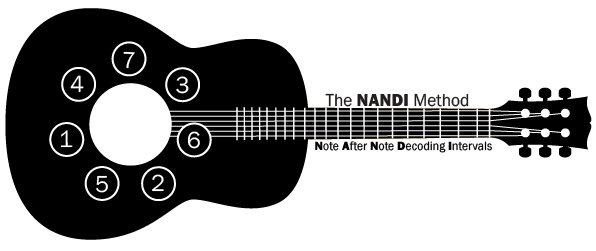Now that you can figure out what notes are in a given key you can start building triads in key. Remember, a triad is a basic 3-note chord. Let’s use the key of C major as an example because it uses all natural notes. We build triads by moving up in thirds. If C is the 1st scale degree, that means the 3rd is E, and the 5th is G (C-D-E-F-G). Now you know the first chord of C major: C-E-G The second chord of C major starts on the next note in the scale, D. When we move up in thirds form D (D-E-F–G-A) we can see the second chord in C major is D-F-A. We can apply this pattern for each note on the scale and figure out each chord.
A simpler way to understand this is by using Roman Numerals. Roman numerals are a shorthand way to understand what chords have what quality. The roman numeral directly correlates to the scale degree of the key. If the numeral is upper case it means the chord is major, if it s lower case it means the chord is minor, and a lower case numeral with a degree symbol (°) means the chord is diminished.
Using C major as an example, the sequence of Roman numerals for major keys is:
I ii ii IV V vi vii°
C Major Cmaj Dmin Emin Fmaj Gmaj Amin Bdim
Chord Quality Major Minor Minor Major Major Minor Diminished
Intervals 1-3-5 2-4-6 3-5-7 4-6-1 5-7-2 6-1-3 7-2-4
Just like each key has seven notes, each key also has seven chords, one for each note. In a major key, all of the chords except for the one built on the 7th scale degree will contain a perfect fifth. Some of the chords contain a minor third, and some contain a major third. It is the difference between the quality of the third that makes a chord major or minor. You will need to be aware of the distance between each note in the triad in order to know its quality. For example, if we lowered the third of our C major chord so that it now looked like C-E♭-G, we have just created a C minor chord.
Using C minor as an example, the sequence of Roman numerals for minor keys is:
i ii° III iv v VI VII
C Minor C D E♭ F G A♭ B♭
Chord Quality Minor Diminished Major Minor Minor Major Major
Intervals 1-♭3-5 2-4-♭6 ♭3-5-♭7 4-♭6-1 5-♭7-2 ♭6-1-♭3 ♭7-2-4
Watch the video below to learn how to identify the chords in a minor key using the Circle of Fourths:
Now, all you have to know is what scale degree you’re playing and you can tell whether or not you should be playing a major, minor, or diminished chord to stay in key.
Relative keys, like C major and A minor, utilize the exact same chords but start at different points. The relative minor is found by moving one sixth up from the root (i.e. the vi chord of a major key is the i chord of its relative minor). Put another way, G major is the V in C major, but the VII in A minor.
Chords In Major Keys
| I Major | ii Minor | iii Minor | IV Major | V Major | vi Minor | vii° Dim |
|---|---|---|---|---|---|---|
| C-E-G | D-F-A | E-G-B | F-A-C | G-B-D | A-C-E | B-D-F |
| F-A-C | G-B♭-D | A-C-E | B♭-D-F | C-E-G | D-F-A | E-G-B♭ |
| B♭-D-F | C-E♭-G | D-F-A | E♭-G-B♭ | F-A-C | G-B♭-D | A-C-E♭ |
| E♭-G-B♭ | F-A♭-C | G-B♭-D | A♭-C-E♭ | B♭-D-F | C-E♭-G | D-F-A♭ |
| A♭-C-E♭ | B♭-D♭-F | C-E♭-G | D♭-F-A♭ | E♭-G-B♭ | F-A♭-C | G-B♭-D♭ |
| D♭-F-A♭ | E♭-G♭-B♭ | F-A♭-C | G♭-B♭-D♭ | A♭-C-E♭ | B♭-D♭-F | C-E♭-G♭ |
| G♭-B♭-D♭ | A♭-C♭-E♭ | B♭-D♭-F | C♭-E♭-G♭ | D♭-F-A♭ | E♭-G♭-B♭ | F-A♭-C♭ |
| B-D#-F# | C#-E-G# | D#-F#-A# | E-G#-B | F#-A#-C# | G#-B-D# | A#-C#-E |
| E-G#-B | F#-A-C# | G#-B-D# | A-C#-E | B-D#-F# | C#-E-G# | D#-F#-A |
| A-C#-E | B-D-F# | C#-E-G# | D-F#-A | E-G#-B | F#-A-C# | G#-B-D |
| D-F#-A | E-G-B | F#-A-C# | G-B-D | A-C#-E | B-D-F# | C#-E-G |
| G-B-D | A-C-E | B-D-F# | C-E-G | D-F#-A | E-G-B | F#-A-C |
Chords In Minor Keys
| Im Minor | II° Dim | ♭III Major | IVm Minor | Vm Minor | ♭VI Major | ♭VII Major |
|---|---|---|---|---|---|---|
| C-E♭-G | D-F-A♭ | E♭-G-B♭ | F-A♭-C | G-B♭-D | A♭-C-E♭ | B♭-D-F |
| F-A♭-C | G-B♭-D♭ | A♭-C-E♭ | B♭-D♭-F | C-E♭-G | D♭-F-A♭ | E♭-G-B♭ |
| B♭-D♭-F | C-E♭-G♭ | D♭-F-A♭ | E♭-G♭-B♭ | F-A♭-C | G♭-B♭-D♭ | A♭-C-E♭ |
| E♭-G♭-B♭ | F-A♭-C♭ | G♭-B♭-D♭ | A♭-C♭-E♭ | B♭-D♭-F | C♭-E♭-G♭ | D♭-F-A♭ |
| G#-B-D# | A#-C#-E | B-D#-F# | C#-E-G# | D#-F#-A# | E-G#-B | F#-A#-C# |
| C#-E-G# | D#-F#-A | E-G#-B | F#-A-C# | G#-B-D# | A-C#-E | B-D#-F# |
| F#-A-C# | G#-B-D | A-C#-E | B-D-F# | C#-E-G# | D-F#-A | E-G#-B |
| B-D-F# | C#-E-G | D-F#-A | E-G-B | F#-A-C# | G-B-D | A-C#-E |
| E-G-B | F#-A-C | G-B-D | A-C-E | B-D-F# | C-E-G | D-F#-A |
| A-C-E | B-D-F | C-E-G | D-F-A | E-G-B | F-A-C | G-B-D |
| D-F-A | E-G-B♭ | F-A-C | G-B♭-D | A-C-E | B♭-D-F | C-E-G |
| G-B♭-D | A-C-E♭ | B♭-D-F | C-E♭-G | D-F-A | E♭-G-B♭ | F-A-C |
